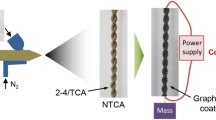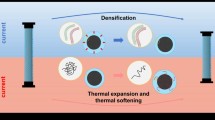Abstract
Developing compliant-artificial muscles for applications in soft robotics and flexible electronics is of practical importance. In this work, we construct Ag-PET (silver-polyethylene-terephthalate) twist-coiled structures from Ag-coated PET. Using electrothermal effect as the actuation mechanism, we demonstrate the contraction of the Ag-PET twist-coiled structures under the action of electric voltage. Increasing electric voltage increases Joule heating, resulting in the increase of the actuation distance and actuation load. Controlling the training load and the rotational speed in the preparation of the Ag-PET twist-coiled structures can tailor the line density of active coils and determine the functionalities of the Ag-PET twist-coiled structures.








Similar content being viewed by others
References
Bar-Cohen Y (2006) Biomimetics using electroactive polymers (EAP) as artificial muscles - A review. J Adv Mater 38:3–9
Duduta M, Hajiesmaili E, Zhao H, Wood RJ, Clarke DR (2019) Realizing the potential of dielectric elastomer artificial muscles. Proc Natl Acad Sci USA 116:2476–2481
Chen YJ, Chen C, Rehman HU, Zheng X, Li H, Liu HZ, Hedenqvist MS (2020) Shape-memory polymeric artificial muscles: Mechanisms, applications and challenges. Molecules 25:4246
Foroughi J, Spinks GM, Wallace GG, Oh J, Kozlov ME, Fang SL, Mirfakhrai T, Madden JDW, Shin MK, Kim SJ, Baughman RH (2011) Torsional carbon nanotube artificial muscles. Science 334:494–497
Aziz S, Spinks GM (2020) Torsional artificial muscles. Mater Horiz 7:667–693
Lee JA, Kim YT, Spinks GM, Suh D, Lepro X, Lima MD, Baughman RH, Kim SJ (2014) All-solid-state carbon nanotube torsional and tensile artificial muscles. Nano Lett 14:2664–2669
Huang YW, Lee WS, Yang F, Lee S (2019) Tensile deformation of artificial muscles: Annealed nylon 6 lines. Polymer 177:49–56
Shahinpoor M, Bar-Cohen Y, Simpson JO, Smith J (1998) Ionic polymer-metal composites (IPMCs) as biomimetic sensors, actuators and artificial muscles - A review. Smart Mater Struct 7:R15–R30
Shahinpoor M, Kim KJ (2004) Ionic polymer-metal composites: III. Modeling and simulation as biomimetic sensors, actuators, transducers, and artificial muscles. Smart Mater Struct 13:1362–1388
He QS, Yin GX, Vokoun D, Shen Q, Lu J, Liu XF, Xu XR, Yu M, Dai ZD (2022) Review on improvement, modeling, and application of ionic polymer metal composite artificial muscle. J Bionic Eng 19:279–298
Wang YF, Wang F, Kong Y, Wang L, Li QC (2022) Novel ionic bioartificial muscles based on ionically crosslinked multi-walled carbon nanotubes-mediated bacterial cellulose membranes and PEDOT: PSS electrodes. Smart Mater Struct 31:025023
Shenoy DK, Thomsen DL III, Srinivasan A, Keller P, Ratna BR (2002) Carbon coated liquid crystal elastomer film for artificial muscle applications. Sens Actuators, A 96:184–188
Liu H, Tian H, Shao J, Wang Z, Li X, Wang C, Chen X (2020) An electrically actuated soft artificial muscle based on a high-performance flexible electrothermal film and liquid-crystal elastomer. ACS Appl Mater Interfaces 12:56338–56349
Yu Y, Li L, Liu E, Han X, Wang J, Xie Y-X, Lu C (2022) Light-driven core-shell fiber actuator based on carbon nanotubes/liquid crystal elastomer for artificial muscle and phototropic locomotion. Carbon 187:97–107
Park J, Yoo JW, Seo HW, Lee Y, Suhr J, Moon H, Koo JC, Choi HR, Hunt R, Kim KJ (2017) Electrically controllable twisted-coiled artificial muscle actuators using surface-modified polyester fibers. Smart Mater Struct 26:035048
Zakeri R, Zakeri R (2022) Bio inspired general artificial muscle using hybrid of mixed electrolysis and fluids chemical reaction (HEFR). Sci Rep 12:1–17
Wang H, York P, Chen Y, Russo S, Ranzani T, Walsh C, Wood RJ (2021) Biologically inspired electrostatic artificial muscles for insect-sized robots. Int J Robot Res 40:895–922
Acknowledgements
SL and HO are grateful to the National Science and Technology Council, Taiwan for their financial support.
Author information
Authors and Affiliations
Corresponding author
Additional information
Publisher's Note
Springer Nature remains neutral with regard to jurisdictional claims in published maps and institutional affiliations.
Supplementary Information
Below is the link to the electronic supplementary material.
Rights and permissions
Springer Nature or its licensor holds exclusive rights to this article under a publishing agreement with the author(s) or other rightsholder(s); author self-archiving of the accepted manuscript version of this article is solely governed by the terms of such publishing agreement and applicable law.
About this article
Cite this article
Liu, YL., Lee, WS., Yang, F. et al. Electrothermally actuated artificial muscles from the silver-polyethylene-terephthalate core–shell structure. J Polym Res 29, 379 (2022). https://doi.org/10.1007/s10965-022-03233-w
Received:
Accepted:
Published:
DOI: https://doi.org/10.1007/s10965-022-03233-w




